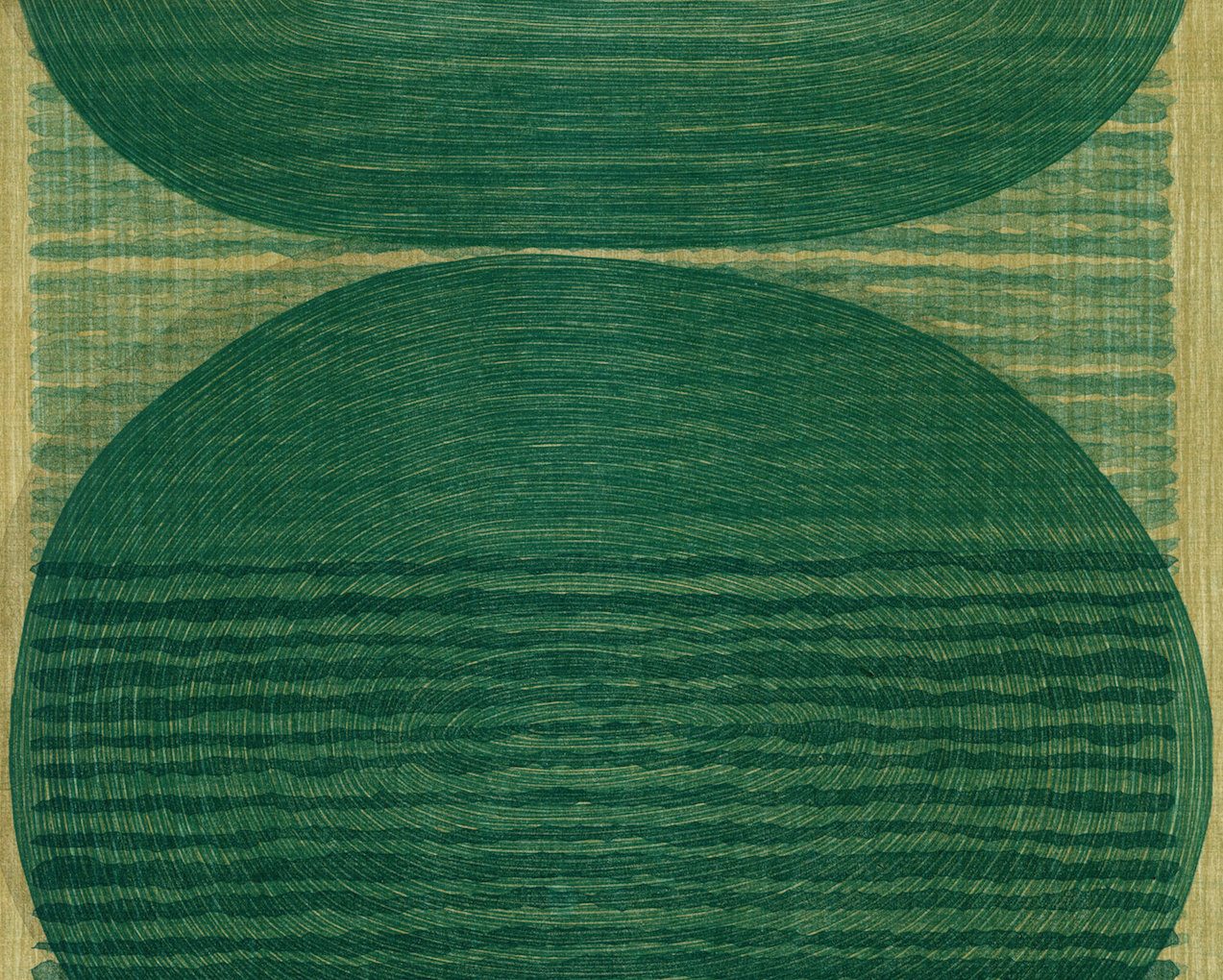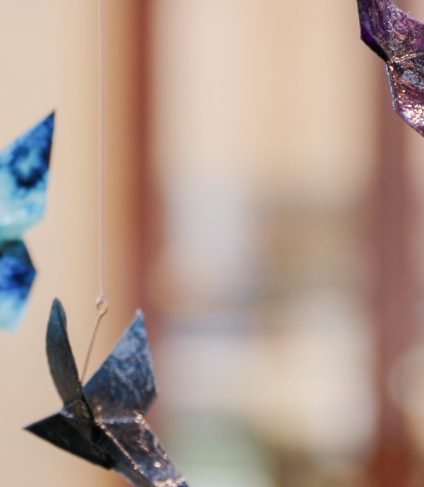Q & A with Visiting Artist Katie Baldwin
Tell us about the workshop that you will be teaching.
Participants will learn how to achieve multiple colors in a woodblock image with perfect registration through the traditional technique of Japanese woodblock printing. This workshop will be an introduction to the printing process mokuhanga, which uses water-based pigments (or sumi ink), a kento registration method, and hand printing with a baren. Participants will learn about tools, materials, as well as the carving sequence and printing methods associated with this process. All participants will have the opportunity to carve and print their own two-color image. One of the wonderful aspects of this process is that it does not require a press, or a large workspace!
When did you first fall in love with printmaking?
I was first introduced to the basics of mokuhanga while I was a student at The Evergreen State College in 1993 by my teacher Peter Ramsey. I was an art student, primarily studying sculpture. However,I became interested in the process of mokuhanga from looking at a Ukiyo-e print hanging on the wall in the print shop. I was curious as Peter described the process and history of the print. Shortly after, I came across a technical book in Japanese woodblock printing at my local library. I spent a few weeks experimenting with cooking rice paste and making a small baren from cardboard, chord and canvas. I carved a woodblock and managed to pull a few humble prints. The idea that the process didn’t require a large studio space and was non-toxic stayed with me. In 2004 I earned my MFA from the University of the Arts in book arts and printmaking. After graduation, I no longer had access to the presses that had been available to me as a student. My creative practice was facing serious limitations: my kitchen table was about to become my studio. That year, I attended the Nagasawa Art Park residency, where I lived and worked for three months, along with other international artists learning about the process of mokuhanga.
Tell us a bit about your experience studying in Japan.
Nagasawa Art Park Residency was the vision of Keiko Kadota. Beginning in 1992, Kadota researched and visited artist residencies and training programs around the world to find models for an art center that would be based in a Japanese village. On a visit to San Francisco, she was deeply impressed by the mokuhanga print works published by Kathan Brown at Crown Point Press. Over the course of ten years, Crown Point Press worked with Japanese master printer, Tadashi Toda, to print works of major contemporary artists like Chuck Close, Helen Frankenthaler, and Francisco Clemente. These prints astonished Kadota with their combination of technical mastery and cutting edge contemporary art, solidifying her determination to introduce this medium to a wider audience of artists.
Kadota started the Nagasawa Art Park program in 1996, and its successor Mi-lab in 2011, in order to spread knowledge of the Japanese woodblock printing process to artists outside of Japan. Since it’s beginning, over 200 artists from more than 30 countries lived, trained, and worked at these programs. Learning about the tradition of tools, materials and process of mokuhanga shaped my studio work. It gave me the skills in a technique that allowed me to continue my work in printmaking and book arts with limited space and equipment. I have continued to explore this technique over the years, returning to Japan in the summer of 2017 for the MI-LAB Advanced Residency and then in 2019 for the Upper Advanced Residency.
What makes Mokuhanga different from European woodblock print or other Japanese woodblock techniques?
First, what is mokuhanga? The word “Moku hanga” in Japanese translates to “Wood block printmaking”. Mokuhanga is the term that contemporary artists have adapted when describing Japanese-style, water-based woodblock printmaking. Traditionally, images that were reproduced using this technique were popularized during the Edo period in Japan (1603-1868). These prints are are called Ukiyo-e. To be precise, water-based woodblock printing itself developed in China during the 7th century AD, primarily for religious practice. It consisted of texts and images that were printed in black and white.
Ukiyo-e is a genre of art in Edo period in Japan, which includes both paintings and prints, that typically depict images of everyday life, such as landscapes, female beauties, kabuki actors, scenes from history and fantasy. The term Ukiyo-e translates to “pictures of the floating world” The technical development, such as the use of Kento registration, played a big role in creating this colorful and complex printed imagery that is different from the other traditional water-based woodblock printing in the East. And the popularization of these types of imagery in Japan also allowed this printing process to flourish within the popular culture. The production of Ukiyo-e prints was a collaborative process. A publisher hired an artist to design an image, or a series of images. The artist created a line drawing which is then given to the carver. The carver then carved the key block. This block is printed in multiple and the artist made notations and instructions for the color layers. After all the blocks are carved, they were sent to the printer to be printed. Often, blocks would be reprinted later–sometimes many years later–when the publisher had sold the first printing and there was still a market for the image. In the Meiji period, the influx of western goods and culture, as well as new and synthetic pigments, influenced the aesthetics and content of the prints, as you can see in this example. In the early 20th century, Shin-hanga fulfilled the popularity and the demand for Japanese culture in the west. Visually influenced by European Impressionism, Shin-hanga still followed the traditional collaborative system with the publisher/artist/carver/printer. During the same time period as Shin-hanga, another movement called Sosaku Hanga spread widely. Sosaku Hanga translates to “creative printmaking”, and the key difference of this movement was that the artists were involved in all aspects of printmaking, including the carving and printing.
What really made the Japanese Ukiyo-e prints stand out was the ability to print very complicated multi-layered color prints with a precise registration method called Kento. It is also characterized by a painterly ink application technique called Bokashi. The process does not require a large work space. You can see in this illustration, everything is placed within reach of the printer. Mokuhanga differs from traditional western approaches to woodblock printing. The kento registration system is carved directly into the block.The Japanese use a specific carving sequence, where shapes and lines are first cut with a knife. The result is very precise carving and it creates a particular kind of slope that supports fine lines and details. The area around the image is cleared with a u-gouge, and then Bull Nose Chisel is used to clean and smooth the carved area around the image. Ink is water based, this can be watercolor, gouache, or sumi ink. The water based pigment is mixed with rice paste directly on the block to create a thin layer of ink. The combination of waterbased pigment and paste will not bleed on damp paper and can handle multiple passes. The pigment is applied with a brush, rather than a brayer or roller. A baren is a hand held disk used for printing, instead of a press. A baren is a disk covered with a bamboo sheath to create the printing tool.
In the past, Mokuhanga involved multiple participants. (one person who drew the piece, carved, inked the wood, etc.) What does one learn by doing it all yourself? Do you ever work in a group?
I do not work in a group to produce prints, but I do work collaboratively on projects. In 2004, Mariko Jesse, Yoonmi Nam and I met at Nagasawa Art Park Residency. In 2013, we began a collaborative project called wood+paper+box. The project came about from our desire to continue the creative dialogue that we shared during the Nagasawa Art Park residency. For a year, we made mokuhanga prints, mailed them to one another, and held mini-residencies together at our own studios. The result of this work is a collection of mokuhanga prints housed in a clamshell box. After this initial project, we decided to continue the conversation and ultimately formed a collaborative of the same name: wood+paper+box.
We produced our second project AL>CA>KS, continuing the format from the first project. As newcomers to the places that we now call home, we shared our individual works investigating the narratives, people, and landscapes where we live. This project was completed in 2016. The content was inspired by the three different states where our studios are located. In 2017, we started our third project titled (un)fold. In this project, we were thinking about the structure, ideas, and acts of folding and unfolding. All of the work has to collapse or fold down to fit within the dimensions of 6 x 9 x 2 inches. We are continue to create collaborative projects together and will be exhibiting at the Beach Museum in Manhattan, KS in the winter of 2021.
What do you hope that people take away from this workshop?
I hope that people will take away the basic understanding of the tools and materials associated with the process of mokuhanga and continue to explore ways to bring this technique into their creative practice.




